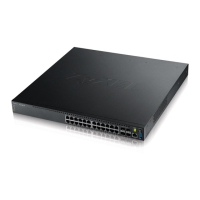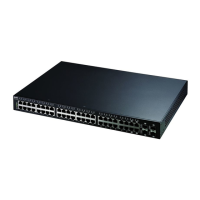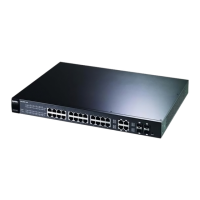Chapter 22 VLAN Stacking
GS3700/XGS3700 Series User’s Guide
226
The following table describes the labels in this screen.
Table 98 Advanced Application > VLAN Stacking > Selective QinQ
LABEL DESCRIPTION
Active Check this box to activate this rule.
Name Enter a descriptive name (up to 32 printable ASCII characters) for identification purposes.
Port The port number identifies the port you are configuring. In stacking mode, the first field is the
slot ID and the second field is the port number.
CVID Enter a customer VLAN ID (the inner VLAN tag) from 1 to 4094. This is the VLAN tag carried in
the packets from the subscribers.
SPVID SPVI D is the service provider’s VLAN ID (the outer VLAN tag). Enter the service provider ID
(from 1 to 4094) for frames received on this port. See
Chapter 7 on page 101 for more
background information on VLAN ID.
Priority Select a priority level (from 0 to 7). This is the service provider’s priority level that adds to the
frames received on this port.
"0" is the lowest priority level and "7" is the highest.
Add Click this to create a new entry or to update an existing one.
This saves your changes to the Switch’s run-time memory. The Switch loses these changes if it
is turned off or loses power, so use the Save link on the top navigation panel to save your
changes to the non-volatile memory when you are done configuring.
Cancel Click Cancel to begin configuring this screen afresh.
Index This is the number of the selective VLAN stacking rule. Click on an index number to change the
settings.
Active This shows whether this rule is activated or not.
Name This is the descriptive name for this rule.
Port This is the port number to which this rule is applied. In stacking mode, the first number
represents the slot and the second the port number.
CVID This is the customer VLAN I D in the incoming packets.
SPVID This is the service provider’s VLAN ID that adds to the packets from the subscribers.
Priority This is the service provider’s priority level in the packets.
Select an entry’s check box to select a specific entry. Otherwise, select the check box in the
table heading row to select all entries.
Delete Check the rule(s) that you want to remove in the Delete column and then click the Delete
button.
Cancel Click Cancel to clear the Delete check boxes.

